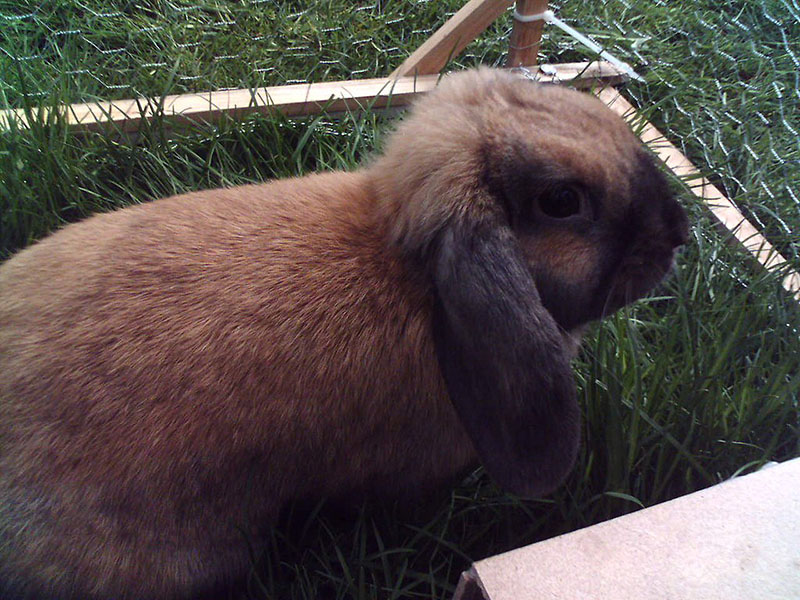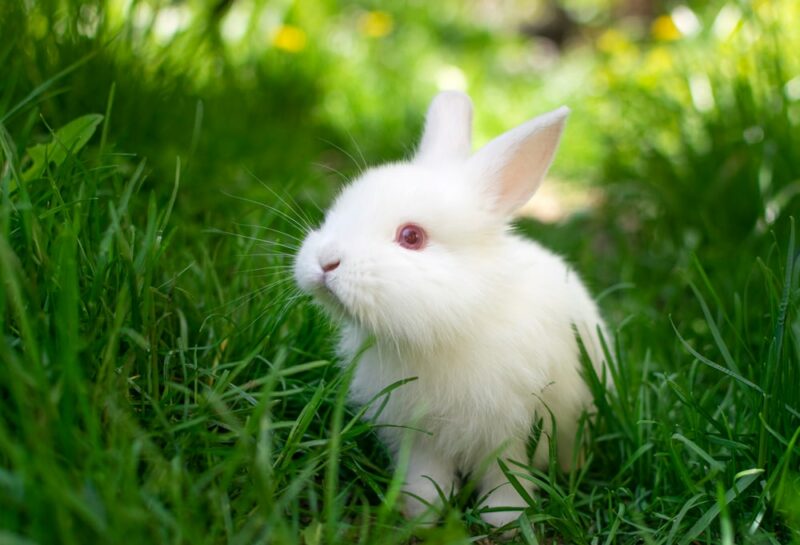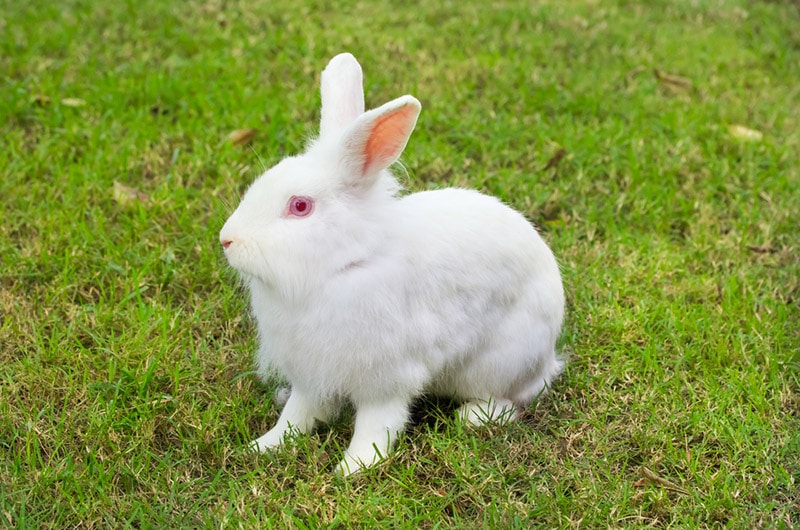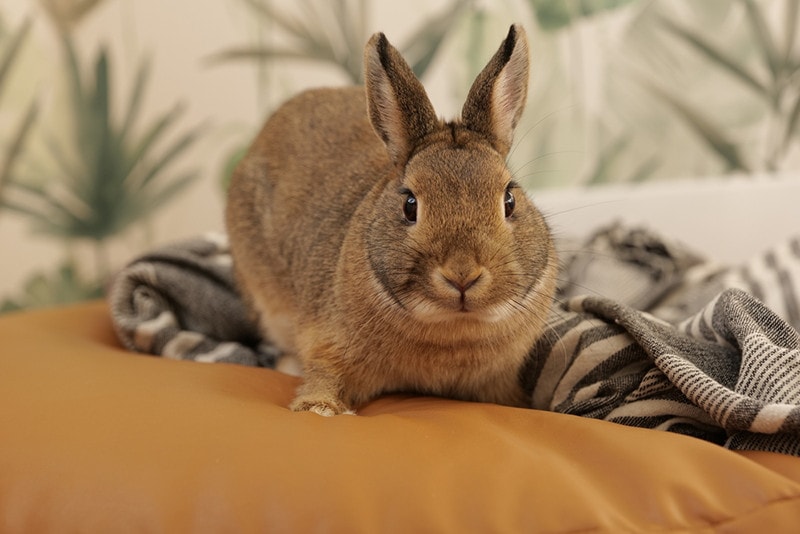Thuringer Rabbit: Info, Care, Diet, Pictures & More
By Adam Mann
Updated on

Click to Skip Ahead
While the Thuringer Rabbit is far from the most common rabbit breed out there, they’re a great choice if you’re looking for a friendly and loving pet. They’re not quite as large as a Flemish Giant Rabbit, but they’re still a bit larger than the average rabbit. But it’s not their size that makes these rabbits such great pets, it’s their award-winning personalities!
| Size: | Above average |
| Weight: | 8–10 pounds |
| Lifespan: | 5–8 years |
| Similar Breeds: | Himalayan Rabbit and Silver Rabbit |
| Suitable for: | Both experienced and beginner rabbit owners |
| Temperament: | Calm, playful, lively, and friendly |
While the Thuringer Rabbit is one of the friendliest rabbit breeds out there, they’re also among the rarest. It’s originally a mix of a few different breeds, and while you can find those breeds relatively easily, tracking down a Thuringer Rabbit remains a bit of a challenge.
Still, they’re great pets, and the more you learn about them, the more you will want one for yourself.
Thuringer Rabbit Characteristics
How Much Do These Rabbits Cost?
If you live in the United States, the hard part of getting a Thuringer Rabbit will be tracking down a breeder. These rabbits are far more common in Europe, but even there, they’re still relatively rare pets.
Because of how rare these rabbits are, you can expect to spend at least $100 for one if you can track down a breeder. However, it will be challenging to track down a Thuringer Rabbit breeder, so be ready to spend a good amount of time reaching out to various rabbit breeders to see if you can find one.
And since these breeders can be so challenging to track down, the price for one of these rabbits will vary quite a bit. Without much competition, it all depends on how many people have found the breeder and want one.
Temperament & Intelligence of the Thuringer Rabbit
Thuringer Rabbits love attention from their owners. Not only do they love the attention, but they’re playful and enjoy rolling around. From there, the Thuringer Rabbit has average intelligence for a rabbit, but because they love attention from their owners so much, they can be a little easier to train.
You can litterbox train a Thuringer Rabbit, and with a little more dedication and consistency, you can teach them to complete simple tricks. They’ll relish the time you spend training them, making it a win-win for both of you!
Do These Rabbits Make Good Pets?
Yes! Whether you’re an experienced rabbit owner or looking to bring your first bunny, the Thuringer Rabbit is an outstanding choice. They’re friendly and have high enough energy levels where they’re fun to play with, but the energy levels aren’t so high that you need to constantly play with them.
As long as you socialize with them often, they’re extremely friendly, and it’s not uncommon for them to climb up into your lap for a nap from time to time. They’re great pets if you can track one down and have the time to meet all their needs.
Does This Rabbit Get Along With Other Pets?
Typically, a Thuringer Rabbit gets along great with other pets and animals, but that doesn’t mean you should house them with just any other animal out there. They typically get along great with other rabbit species. In fact, they’re sociable rabbits and often do better in groups instead of on their own.
However, you shouldn’t house them with other species like guinea pigs or rats. They might not get along, but more concerning is the fact that they can spread diseases to each other and have drastically different diets.
Finally, Thuringer Rabbits will usually get along with dogs and cats, but you need to monitor the behavior of your dogs and cats to ensure they’re not terrorizing the rabbit!
Things to Know When Owning a Thuringer Rabbit:
If you’re considering bringing a Thuringer rabbit home, you need to know exactly what you’re getting yourself into. They’re not the most complicated rabbit to care for, but you’ll still want to know some of the basics so you’re ready to give them everything they need from day one.
Food & Diet Requirements
A Thuringer Rabbit will eat a diet identical to any other rabbit breeds out there. This means the vast majority of your Thuringer Rabbit’s diet should consist of fresh, clean hay or grass. From there, you can supplement their diet with small amounts of leafy greens and pellets.
And contrary to what you might think, root vegetables like carrots don’t naturally eat these types of foods, so you should only give them some in very small quantities as the occasional treat.
Habitat & Hutch Requirements
As a general rule, a rabbit cage should be at least four times the size of the rabbit. For a Thuringer Rabbit, this usually works out to a cage that’s about 30″ x 36″. Furthermore, we recommend a hutch with these dimensions and a second level for your rabbit to explore.
A second level with a connected ramp doubles the amount of space your rabbit has to roam without taking up extra floor space. Keep in mind that these are the minimum requirements for a single Thuringer Rabbit, you’ll need to add additional space if you want to house multiple rabbits in the same hutch.
Exercise & Sleeping Needs
Just because you have a hutch that’s large enough for your Thuringer Rabbit doesn’t mean they don’t need time outside of their cage each day. Rabbits benefit from time outside of their hutch to stretch their legs and exercise a bit. You can either have a room where they can run around or have a larger enclosure with a mesh fence around it to keep your rabbit safe.
Meanwhile, adult rabbits in captivity will sleep about the same amount of time as us, averaging just under 8.5 hours of sleep each day. They also sleep at night, so they should be active most of the time that you are!
Training
While you’re likely not going to train your Thuringer Rabbit super complex tricks, you can train them to complete simple tricks, and you can even train them to use a litter box. When trying to train them to do anything, stay consistent and positive during the training process for the best possible results.
Grooming
The Thuringer Rabbit has a medium coat length, and because of this, they need you to brush out their coats several times a week. Not only will this help reduce the amount they shed, but it will also help keep their hair from matting or knotting up because of the length.
Don’t worry, though, brushing out your rabbit is just another excuse to interact with your rabbit and pet its silky-smooth fur!
Lifespan and Health Conditions
The Thuringer Rabbit has an average lifespan for a rabbit, typically living at least 5 years, but sometimes they can live up to 8 years! They also don’t suffer from any more health concerns than any other rabbit breed.
But while they’re not more susceptible to health problems, there are still a few you’ll want to keep an eye out for to keep your Thuringer Rabbit happy and healthy. We’ve highlighted some of the most common health problems for you to look out for here:
- Dental problems
- Ear mites
- Intestinal problems
- Uterine cancer
- Myxomatosis
- Viral hemorrhagic disease
- Hairball obstructions
- Bloat
Male vs Female
If you’re looking at getting a Thuringer Rabbit, you likely won’t be able to tell any difference between a male and a female. We recommend spaying or neutering any Thuringer Rabbit you plan on getting, but otherwise, you shouldn’t house males and females together unless you want baby bunnies.
3 Little-Known Facts About Thuringer Rabbits
Since Thuringer Rabbits are so rare, it’s no surprise that there’s no shortage of little-known facts about them out there. We’ve highlighted three of our favorites we think you should know about for you here:
1. Thuringer Rabbits Come From Germany
Mr. David Gartner combined Himalayan Rabbits, Silver Rabbits, and Flemish Rabbits to create the Thuringer Rabbit, and he did all this in Thüringer, Germany. This is where the breed gets its name, clearly!
2. Thuringer Rabbits Were Once Commercial Rabbits
While you might think of the Thuringer Rabbit as a pet today, when Mr. Gartner first created the breed, he wasn’t looking for a furry companion. Instead, he was looking for a rabbit with high-quality fur and tasty meat.
But while Mr. Gartner didn’t breed the Thuringer Rabbit for their award-winning personality, there’s no denying they have one!
3. They Almost Went Extinct After WWII
Like many animal breeds around the world, the Thuringer Rabbit almost didn’t make it through World War II. A few determined breeders kept the breed alive, but the numbers have never completely rebounded to the pre-World War II numbers.
Final Thoughts
If you can track down a Thuringer Rabbit and want a pet bunny, you won’t regret going with this breed. They’re outstanding pets with amazing personalities, and they’re pretty easy to care for. It will take a bit more work to find one in the first place, but when you have your loving rabbit in your home, it’s all more than worth it!
Featured Image Credit: Widderzwerg (Waugsberg, Chefchen, Wikimedia Commons CC SA 3.0 Unported)












